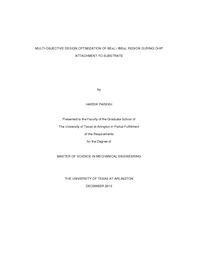
ATTENTION: The works hosted here are being migrated to a new repository that will consolidate resources, improve discoverability, and better show UTA's research impact on the global community. We will update authors as the migration progresses. Please see MavMatrix for more information.
Show simple item record
| dc.contributor.author | Parekh, Hardik | en_US |
| dc.date.accessioned | 2014-03-12T23:52:08Z | |
| dc.date.available | 2014-03-12T23:52:08Z | |
| dc.date.issued | 2014-03-12 | |
| dc.date.submitted | January 2013 | en_US |
| dc.identifier.other | DISS-12413 | en_US |
| dc.identifier.uri | http://hdl.handle.net/10106/24148 | |
| dc.description.abstract | Semiconductor industry has recognized the need to replace traditional Al/SiO2 interconnects with Cu/Low-k interconnects in the mainstream electronics devices following the latter's impact on power, RC delay, and cross-talk reduction. However due to lower elastic modulus, strength, and poor adhesion characteristic, reliability of the Cu/Low-k interconnects turns out to be a concern for its integration in the back-end-of-line (BEoL). Flip-chip attachment process (cooling from ~200C to room) can result in critical damage in nano-scale Cu/Low-k interconnects. The objective of this study is to improve the reliability of Cu/Low-k interconnects during die attach reflow process for a specific die to substrate size ratio by varying a group of design parameters such as substrate thickness and solder bump footprint. Preliminary parametric study has shown that the variation in the concerned design variables has a significant effect on the solder bump (fBEoL) and low-k layer damage (BEoL) [1]. However, there is a trade-off between the solder bump and the dielectric damage with bump footprint, thereby arising a need to perform a multi-objective design optimization. A simulation based multi-objective design optimization has been carried out to improve BEoL/fBEoL reliability under reflow loading by minimizing the following objective functions 1) strain energy in solder bump and 2) peeling stress in dielectric (low-k layers). This work is of immense importance from process integration standpoint. It can provide a quantitative upstream guideline to the process/electrical team on the BEoL/fBEoL damage. | en_US |
| dc.description.sponsorship | Agonafer, Dereje | en_US |
| dc.language.iso | en | en_US |
| dc.publisher | Mechanical Engineering | en_US |
| dc.title | Multi-objective Design Optimization Of BEol/fBEol Region During Chip Attachment To Substrate | en_US |
| dc.type | M.S. | en_US |
| dc.contributor.committeeChair | Agonafer, Dereje | en_US |
| dc.degree.department | Mechanical Engineering | en_US |
| dc.degree.discipline | Mechanical Engineering | en_US |
| dc.degree.grantor | University of Texas at Arlington | en_US |
| dc.degree.level | masters | en_US |
| dc.degree.name | M.S. | en_US |
Files in this item
- Name:
- Parekh_uta_2502M_12413.pdf
- Size:
- 1.644Mb
- Format:
- PDF
This item appears in the following Collection(s)
Show simple item record


